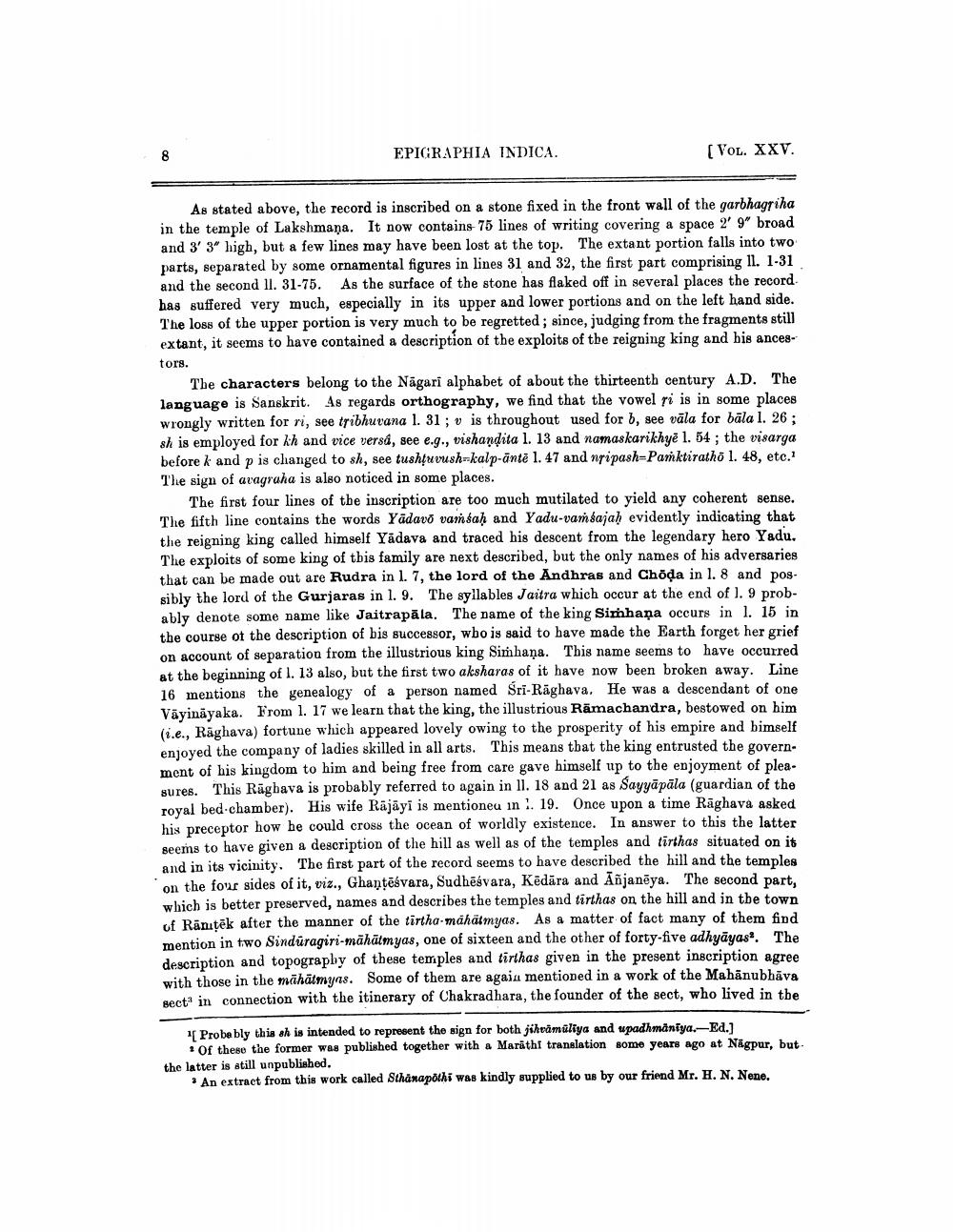________________
EPIGRAPHIA INDICA.
(Vol. XXV.
As stated above, the record is inscribed on a stone fixed in the front wall of the garbhagriha in the temple of Lakshmana. It now contains 75 lines of writing covering a space 2' 9" broad and 3' 3" high, but a few lines may have been lost at the top. The extant portion falls into two parts, separated by some ornamental figures in lines 31 and 32, the first part comprising 11. 1-31 and the second ll. 31-75. As the surface of the stone has flaked off in several places the record has suffered very much, especially in its upper and lower portions and on the left hand side. The loss of the upper portion is very much to be regretted; since, judging from the fragments still extant, it seems to have contained a description of the exploits of the reigning king and bis ancestors.
The characters belong to the Nagari alphabet of about the thirteenth century A.D. The language is Sanskrit. As regards orthography, we find that the vowel ri is in some places wrongly written for ri, see tribhuvana 1. 31; v is throughout used for b, see vāla for bāla l. 26; sh is employed for kh and vice versá, see e.g., vishandita 1. 13 and namaskarikhye 1. 54; the visarga before k and p is changed to sh, see tushtuvush-kalp-ante 1. 47 and nipash-Parktiratho 1. 48, etc. The sign of avagraha is also noticed in some places.
The first four lines of the inscription are too much mutilated to yield any coherent sense. The fifth line contains the words Yādavo vamśaḥ and Yadu-vamsajah evidently indicating that the reigning king called himself Yādava and traced his descent from the legendary hero Yadu. The exploits of some king of this family are next described, but the only names of his adversaries that can be made out are Rudra in l. 7, the lord of the Andhras and Choda in 1.8 and pos. sibly the lord of the Gurjaras in 1. 9. The syllables Jaitra which occur at the end of l. 9 probably denote some name like Jaitrapāla. The name of the king Simhana occurs in l. 15 in the course of the description of bis successor, wbo is said to have made the Earth forget her grief on account of separation from the illustrious king Simhaņa. This name seems to have occurred at the beginning of l. 13 also, but the first two aksharas of it have now been broken away. Line 16 mentions the genealogy of a person named Sri-Rāghava. He was a descendant of one Väyinäyaka. From 1. 17 we learn that the king, the illustrious Ramachandra, bestowed on him (i.e., Rāghava) fortune which appeared lovely owing to the prosperity of his empire and bimself enjoyed the company of ladies skilled in all arts. This means that the king entrusted the government of his kingdom to him and being free from care gave himself up to the enjoyment of pleasures. This Rügbava is probably referred to again in 11. 18 and 21 as Sayyāpāla (guardian of the royal bed-chamber). His wife Räjāyi is mentioneu in l. 19. Once upon a time Rāghava asked his preceptor how he could cross the ocean of worldly existence. In answer to this the latter seems to have given a description of the hill as well as of the temples and tirthas situated on it and in its vicinity. The first part of the record seems to have described the hill and the temples on the four sides of it, viz., Ghaņtēšvara, Sudhēsvara, Kēdāra and Añjanēya. The second part, which is better preserved, names and describes the temples and tirthas on the hill and in the town of Ranıtēk after the manner of the tirtha-mahatmyas. As a matter of fact many of them find mention in two Sinduragiri-māhātmyas, one of sixteen and the other of forty-five adhyāyas. The description and topography of these temples and tirthas given in the present inscription agree with those in the māhātmyns. Some of them are agaia mentioned in a work of the Mahānubhāva sect in connection with the itinerary of Chakradhara, the founder of the sect, who lived in the
1 Probe bly this sh is intended to represent the sign for both jihramūliya and upadhmānīya.-Ed.]
+ Of these the former was published together with a Marathi translation some years ago at Nagpur, but the latter is still unpublished.
* An extract from this work called Sthanapöthi was kindly supplied to us by our friend Mr. H. N. Nene.




